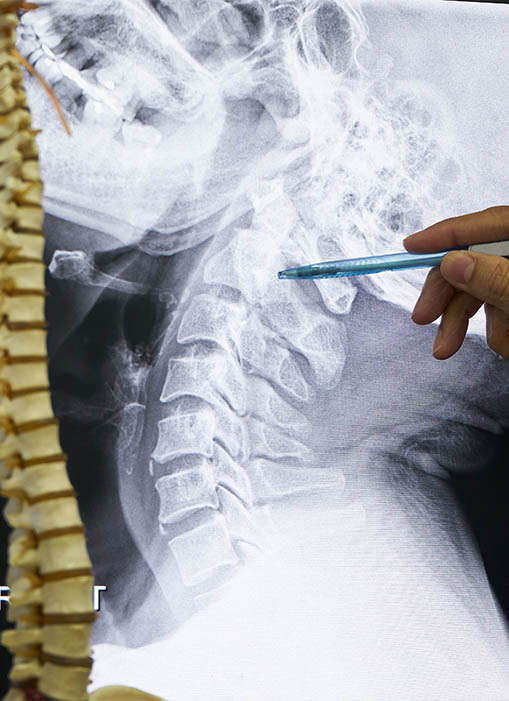Back and Neck Pain
Learn more about our capabilities for treating neck, back, and lower back pain.
Quick Facts on Back & Neck Pain
- Back, lower back, and neck pain can develop from everyday wear and tear, overuse, or even basic home or work tasks.
- Risk of back and neck pain will increase with age, predispositions, or job conditions.
- If back problems occur in children under the age of 20 or adults over the age of 50, they are more likely to have a serious cause.
- Our team of specialists, orthopedic surgeons, on-site doctors, and physical therapy services providers work together to find the best recommendation for your specific pain.
Understanding back and neck pain.
Most people will experience minor back problems and pain at one time or another. Symptoms develop from everyday wear and tear, from an overuse injury, during sports or recreational activities, and from injury during work or home tasks. Back pain can occur anywhere from the neck to the tailbone (coccyx). Back injuries are the most common cause of back pain, whether those injuries arise from daily activity, tripping, falling or twisting the spine; or severe back injury from trauma; car accidents, direct blows to the back or the top of the head.
Your risk of back pain increases as you age, if you have a family history of back pain, sit for long periods, lift heavy objects, or have a degenerative disease such as osteoporosis. Although most back problems occur in adults aged 20 to 50, if they occur in children under the age of 20 or adults over the age of 50, they are more likely to have a serious cause.
Our team of back and neck pain specialists, doctors, and caregivers can help.

What are the regions and structures of the spine?
Even a basic understanding of the regions and structures of the lumbar spine can help you be more involved in your healthcare and better able to care for your back problem.
The human spine is made up of 24 stacked bones (vertebrae) and cushions of soft tissue (discs) together forming the spinal column. When seen from the side the spine forms three natural curves. The cervical curve is the neck area. The thoracic curve is at the chest level and the lumbar curve is the lower back. The sacrum and coccyx are 2 fused bones at the bottom of the spine. Viewed from back to front, the spinal column should be in a straight line. When properly aligned, it keeps the body balanced and comfortable. The spinal column is the body’s main upright support.
The lumbar vertebral bodies are taller and bulkier compared to the rest of the spine. This is partly because the low back has to withstand pressure from body weight and from movements such as lifting, carrying, and twisting. Large and powerful muscles attaching on or near the lumbar spine place extra force on the lumbar vertebral bodies.
The discs normally work like shock absorbers. They protect the spine against the daily pull of gravity. They also protect the spine during heavy activities that exert strong force, such as jumping, running, and lifting.
The spinal cord is like a long wire made up of millions of nerve fibers. Just as the skull protects the brain, the bones of the spinal column protect the spinal cord. Between vertebrae, two large nerves branch off the spinal cord, one on the left and one on the right. These spinal nerves group together form the main nerves that go to the organs and limbs. The nerves of the lumbar spine (cauda equina) go to the pelvic organs and lower limbs. A bulged or herniated disc can narrow the opening and put pressure on the nerve. The muscles of the low back are arranged in layers. The middle layer, called the erector spinae, has strap-shaped muscles that run up and down over the lower ribs, chest, and low back. They join in the lumbar spine to form a thick tendon that binds the bones of the low back, pelvis, and sacrum. The deepest layer of muscles attaches along the back surface of the spine bones, connecting the low back, pelvis, and sacrum. These deepest muscles coordinate their actions with the muscles of the abdomen to help hold the spine steady during activity.
How is neck and back pain treated?
Whether you have had a neck or back problem for some time or have just started experiencing neck and back pain, our clinics are ready to treat your back and neck pain. We help you find the cause and get you on the road to recovery often the same day. Most neck or back pain can be relieved without the need for invasive treatment or surgery. We bring together our team of back pain doctors and specialists and sophisticated technology to focus on you and your back. We offer swift, accurate diagnosis and immediate pain management. Our team of specialists will explore all other avenues of treatment before recommending surgery to treat your back pain.

Meet Our Doctors
From Johns Hopkins to The Mayo Clinic to New York’s Hospital for Special Surgery, our doctors have trained at the world’s leading medical institutions.
View Our Locations
Find the Precision facility that is closest to you among our 12 locations throughout Maryland.